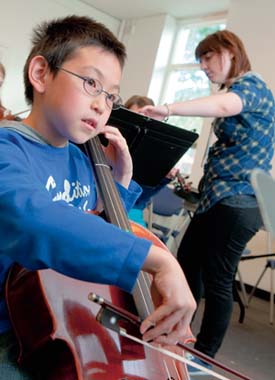 |
 |
| current issue |  | past issues |  | send a letter/news |  | address update |  | advertise |  | about us |  | alumni home |
Campus Currents
|
First String
UNH helps fill a gap in music education By David Moore |
Easy to print version |

|
On a Thursday evening in late May the air is warm and humid, but inside the Paul Creative Arts Center it's positively stifling. Faculty cellist Larry Veal is perspiring, even though he's wearing a short-sleeved Hawaiian shirt, as he hops incessantly back and forth among the four offices and practice rooms where local grade-school children are rehearsing for their spring concert the following Tuesday.
"Come on strong on that second beat," Veal tells a group working on the beginner's classic "Kookaburra." "You want to feel the beat waaaay down in your tummy. You know what we say, 'It don't mean a thing...'" and then everybody joins in, "if it ain't got that swing!" Veal hears them through one more round. Then, satisfied, he darts across the hall, where 35 children, six UNH student-teachers and master teacher Sally Wituszynski '07G are putting the finishing touches on "French Folk Song." By the end of the rehearsal, the 2010 UNH String Project players are as ready as they are going to be.
In an age when young people are surrounded by opportunities to consume music, cutbacks in public music education have made it harder than ever to make music. Wituszynski, who teaches string instruments at Berwick Academy in Maine, says that the String Project at UNH, one of the 35 colleges in the National String Project Consortium, is filling an important gap. "There's a high demand for affordable stringed instrument instruction," she says. For roughly the same price families would pay for introductory soccer, children can participate in two semesters of weekly musical instruction on campus, taught by project director Veal, Wituszynski and a group of UNH music education majors excited by the chance to get hands-on teaching experience.
"I have been playing the violin since I was 8, but teaching others how to play and read music is harder than performing it," says Emily Grondin '11, whose grandfather Rod Grondin '62 also studied music at UNH. "As a teacher, you have to unlearn what's automatic to you," she says. "For example, what do I say when a student asks me why there are quarter notes instead of whole notes?"
That's where Veal and Wituszynski come in. "We teach the teachers," says Wituszynski, "how to break music down so that students can put it back together again."
On concert night, Bratton Recital Hall is packed as musicians take the stage. The beginner's group starts off, performing to an appreciative audience of family and friends. "I think my classes are awesome," says third-grader Emma Wiechert of Durham, who became hooked after hearing Grondin and company perform a string rendition of Coldplay's "Viva la Vida" at her school. "I always wanted to play the violin. This is a golden opportunity."
blog comments powered by Disqus
